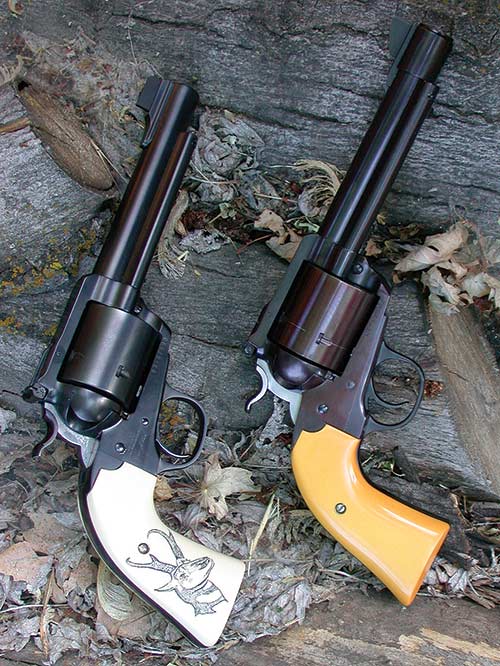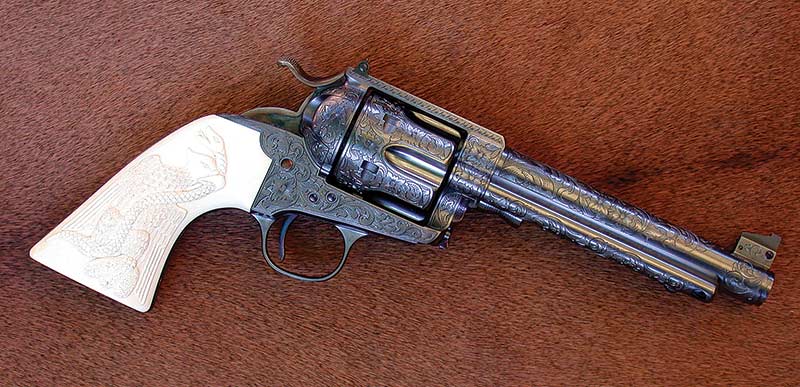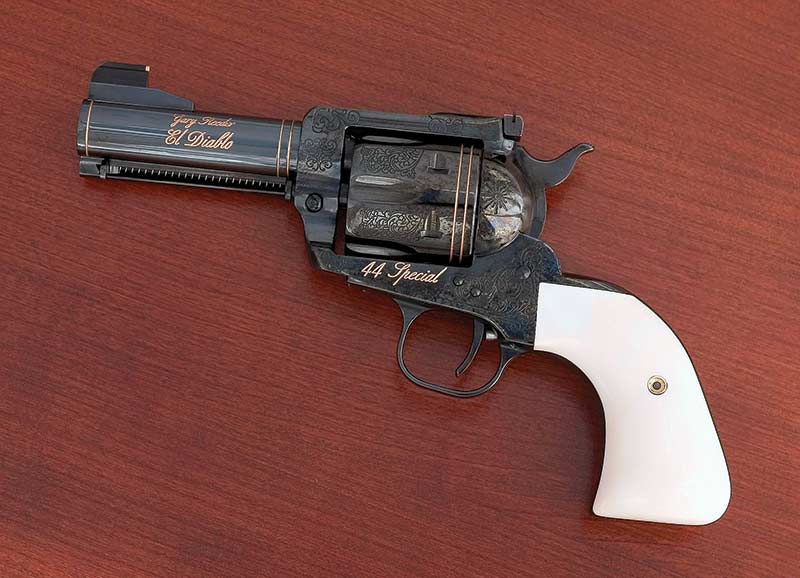Why A Custom Sixgun?
With all the grand handguns currently offered, why would anyone want to spend the money to build a custom sixgun? An entire book could be written on this subject; in fact it has, The Custom Revolver, by Hamilton Bowen. Hamilton’s not only one of the top sixgunsmiths plying his craft today, but also one of the top sixgun artisans of all time. Hamilton’s book does not answer the how so much, but rather the “what” and “why” of custom sixguns.
Words From A Master
Quoting from the preface to his book we have these words from Hamilton: “Custom revolvers are commissioned for as many reasons as there are custom revolver owners. The marketplace may not offer exactly what some shooters desire. Others may find\ exactly what they want but may find that what they got does not perform exactly as they planned. Connoisseurs simply delight in the refinement and absolute quality that only bespoke handwork affords. Still others just want something different for the pure, unmitigated hell of it. While there are a great many reasons to alter factory products, the truth of the matter is that the vast majority of such guns never land on a custom pistolsmith’s bench. Their owners are entirely content, which might lead a disinterested observer to opine that perhaps the subject of custom revolvers hardly warrants a pamphlet let alone a whole book. Custom revolvers are not a subject of vast import in the overall scheme of things, but there’s a small group of enthusiasts on the planet who regard them with great curiosity and passion.”
Good Old Days
When it comes to handguns, in a sense, these are the “good old days.” A look at the first issue of Gun Digest in the 1940s reveals a handful of pages with very large pictures of handguns — the latest issue devotes over 50 pages. Never have so many handguns in so many variations been so readily available. Relatively speaking, they are also less-expensive than they were a halfcentury ago. We have choices running the gamut from 12 ounce .357s up to four and five-pound big bore behemoths. Current firearms are held to tighter specifications and made of higher quality steels than those found 50 years ago. What is missing is the beautiful hand fitting and heart stopping finishes especially as found in pre- WWII sixguns.
Meaning Of Is
Permit me to expand a little on what Hamilton has said. I also encourage everyone who truly enjoys custom revolvers — or even just the thought of same — to obtain a copy of his book. A custom sixgun is not an investment unless one is speaking of an investment in pure pleasure and pride of ownership. Rarely does a custom sixgun ever recoup the dollars invested. It is instead a personal thing built to one person’s specifications of the ultimate dream gun. It’s not always possible to find someone who shares the same dream. Perhaps off in the distant future custom sixguns by today’s sixgunsmiths will be regarded as the works of art they are and bring even higher dollars than were originally invested. But perhaps not in our lifetime.
Dream On
I use the term dream gun. I’m a dreamer; always have been and hope I always will be. While working fulltime on a factory night shift and attending classes full-time at a university, I needed dreams to help keep me going. Many of those dreams revolved around custom sixguns found in Elmer Keith’s 1955 book, Sixguns. I looked at them over and over and thought — someday. Even after college and moving to Idaho I still had to live on dreams with three kids to provide for. I still have the catalog from Trapper Gun with so many custom sixguns for me to look at and think — someday.
When we are young we don’t think “someday” will ever arrive, but it does. Kids grow up and go out on their own and we actually arrive at a time in our life when we have expendable dollars. Suddenly dreams can come true. If your time hasn’t arrived yet, be patient, it surely will.
So what are some reasons for customizing sixguns and building custom sixguns? The two ideas are not the same. The former seeks to improve a factory product while the latter normally signifies the conversion to a different caliber and look. Many custom efforts are expended simply to “improve” a factory sixgun. Revolvers are manufactured by imperfect people using imperfect machines yet they are for the most part totally usable right out of the box. However for that relatively small group wanting more, there are several things to be done to to make them more accurate — or simply better — in the eyes of the beholder.
Improve The Good
Today, good triggers and smooth actions are seldom found on factory revolvers, but this was not always so. An out of the box S&W from the 1950s is normally found to be already smoothed and tuned, with a heavenly trigger pull. Not so today. Most revolvers from most manufacturers come with a trigger pull about double what is desirable and a not so smooth, often gritty action. A good gunsmith can perform wonders in both of these areas. Cylinders often have more play than necessary, and again a custom sixgunsmith can fix this. Factory grips are often found to be slightly loose and oversized for their particular frame; again a custom ‘smith can fix this.
In the search for accuracy, cylinder throats are often found to be undersized and can be opened to the proper dimensions. On single action sixguns two operations often performed are the installation of a Belt Mountain base pin take out some of the looseness of the cylinder. A second easily installed improvement is a larger ejector rod head to facilitate the removal of fired cartridges.
Other personal improvements include the installation of better sights, a front sight in a dovetail for windage adjustment on fix-sighted sixguns, and even the installation of adjustable sights on fix-sighted revolvers. In many cases the only models available have longer than desired barrel lengths. The Bisley Model from Ruger has only been cataloged with a 71⁄2″ barrel and these are routinely cut back to 51⁄2″ or 45⁄8″. The same is true of the Super Redhawk. Mag-Na-Port offers a special package on the latter which includes tuning, porting, and shortening the barrel to 4.8″ resulting in a much easier shooting and handling package. At the other end of the spectrum, long before Ruger offered a 101⁄2″ barrel on their Super Blackhawk, I had Trapper Gun customize a Super Blackhawk by adding a 10″ Long Range barrel and finish in satin nickel which approximated the yet to be offered stainless-steel factory version.
The Connoisseur
Now we come to the true custom sixguns, built to provide something that doesn’t exist or to duplicate a classic. The majority of custom sixguns are built on Ruger platforms like Flat-Tops, Old Models, Vaqueros, Redhawks, and even Super Redhawks. In all probability the most commissioned custom single action sixguns are built on the original Ruger .357 Magnum Blackhawk, the Flat-Top of 1955 and its successor the Old Model. These old sixguns are prized for their size and their traditional actions, in both cases basically the same as that classic of classics, the Colt Single Action Army.
The Rugers were never offered in .44 Special and the custom sixgunsmith can correct this. Other calibers suitable for this conversion are .41 Special, .38-40, .44-40, .45 Colt, .45 Schofield and even .45 ACP — all of which can be built by re-chambering the original cylinder. If you’re willing to go with a custom cylinder, a dream .32-20 can also be built on one of these old Rugers. Add a case-hardened frame and hammer matched up with a beautiful blue job and you have a true classic.
Heavy Duty
Sometimes a heavier sixgun is desired and this is where the New Model Blackhawk and Redhawk enter. Five-shot versions in .45 Colt, .454 Casull, .480 Ruger, .475 and .500 Linebaugh can all be built on these platforms. Free spinning cylinders on the single actions and L-frame barrels on the double actions are often used. The Redhawk has never been offered in any barrel shorter than 51⁄2″ (only just now, Ruger is offering it with a 4″ barrel!), and a custom sixgun with a round-butt and a 4″ barrel in any of the above calibers makes a formidable heavy-duty packin’ pistol. I’m sure Hamilton will be doing his magic to those new 4″ Redhawks.
DA Dream Guns
One of the rarest factory sixguns is a fix-sighted S&W .44 Special such as the 1926 Model or the 1950 Model. A viable solution is a .38-44 Heavy Duty converted to .44 Special or even .45 Colt. If you can find one, one of the newer Thunder Ranch .44 Specials or .45 ACP models of fixed-sighted Nframes would make great project guns.
The Model 58 from Smith & Wesson is often used for fix-sighted conversions to .44 Magnum or .45 Colt complete with a new barrel enclosing the ejector rod. In 1954 S&W introduced the matte blue finished .357 Magnum Highway Patrolman. This is an excellent choice for conversion, especially to .44 Special.
The Model 1917s produced by both Colt and S&W for service in WWI routinely carried lanyard rings as did many later Colt New Service sixguns. The idea of the lanyard ring is back and is often added to custom sixguns.
When it comes to custom sixguns the practical shooter buys a factory product and says why bother customizing it? But the dreamer/connoisseur says — why not? The best reasons for commissioning a custom sixgun is simply because we want to — and we can. For the next several issues we will be looking at several custom sixgunsmiths and their offerings. Enjoy and dream.
For more info on Hamilton’s book: Bowen Classic Arms, www.bowenclassicarms.com.
Subscribe To American Handgunner

Get More Revolver Content Every Week!
Sign up for the Wheelgun Wednesday newsletter here:









